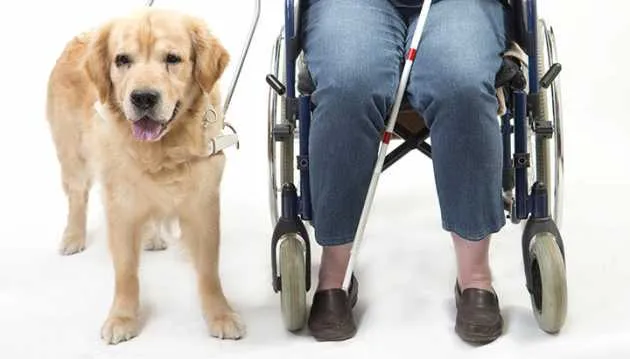It is common knowledge that service animals, such as guide dogs for the blind, provide a valuable service for their humans. These animals help their owners to get where they need to go and do what they need to do. They also help to keep their owners safe by sensing and responding to emergencies. Along with blind people, service dogs (or miniature horses) often accompany deaf and wheelchair-bound individuals, as well as people with seizure disorders.
Traveling by plane with a service animal
When traveling by plane, most people that wish to take their animals with them must have them placed in an airline hold or buy an extra seat. Whichever route you choose, fees to travel with pets can be steep.
Service animals, however, are exempt from this law. Owners do not have to pay fees when traveling with their animals. The accompaniment of a service animal cannot be refused by the airline, either. This makes sense: service animals provide a necessary service to their humans — sometimes saving their lives.
Emotional Support Animals (ESAs)
However, there is a murkier category of animals often traveling by air these days, and that’s Emotional Support Animals, also known as an ESAs. Under the current guidelines, emotional support animals can be virtually any animal.
These animals do not have to provide any specific service aside from, as their name implies, emotional support. Someone who is diagnosed with depression, anxiety, PTSD, phobias, stress disorders or certain other conditions can apply to have their pet registered as an Emotional Support Animal. If the pet is registered, they are allowed to travel with their human for free.
This practice makes sense in a lot of ways. Animals can be extremely helpful to people suffering from psychological and emotional disorders. For just one example, someone who has panic attacks on a flight may be soothed by their furry friend and avoid a nightmare traveling experience. If a person has a special bond with an animal, that bond may be a saving grace in facing psychological problems and getting through day-to-day life smoothly. I truly feel for these people and understand the need for these types of animals to be able to travel with their owners unrestricted.
Misuse of service animal law

However, there’s a problem. There has recently been a great deal of fraud surrounding the issue of both service animals and Emotional Support Animals. Many people who want to travel with their pets will disguise their pet as one or the other. Some people buy their dogs vests that look like service animal vests. Others have been passing off their regular pets as Emotional Support Animals. The prevalence of this problem has left airlines understandably vexed and a solution has not been easy to find.
Brian Skewis, executive officer of the California State Board of Guide Dogs for the Blind, says, “I see more violations than legitimate use of service dogs in public. A drastic majority of what I’ve observed in airports is misuse of the service dog law.”
Ambiguous laws make cracking down tough
Rod Haneline, chief programs and services officer for Rochester’s Leader Dogs for the Blind, agrees. He states, “The law is so ambiguous the airlines don’t know what side to come down on. Everyone is afraid of the ramifications of not allowing someone equal access.”
On this matter, Haneline adds:
“It’s the Wild West. Animals are much more connected to our daily lives, and the last thing people want to do is put their dog into a pet carrier and put them in the hold of an airplane. This is kind of an easy way to (avoid that) without paying.”
The delicate nature of the situation
The Department of Transportation has had some discussions about this matter. But as of right now, there has been no consensus. No timeline is in place for nailing down approaches to the issue of fraud.
It’s easy to see the delicate nature of the situation: denying equal access to someone with a legitimate need for a service or ESAs would be unacceptable. However, the way that the law is now, people can easily slip their pets by the radar.
What do you think: Should there be more stringent requirements for service animals and ESAs at the airport? How might we go about this scenario in a way that’s fair to people who really need their animals on board?
– Tanya Mead

